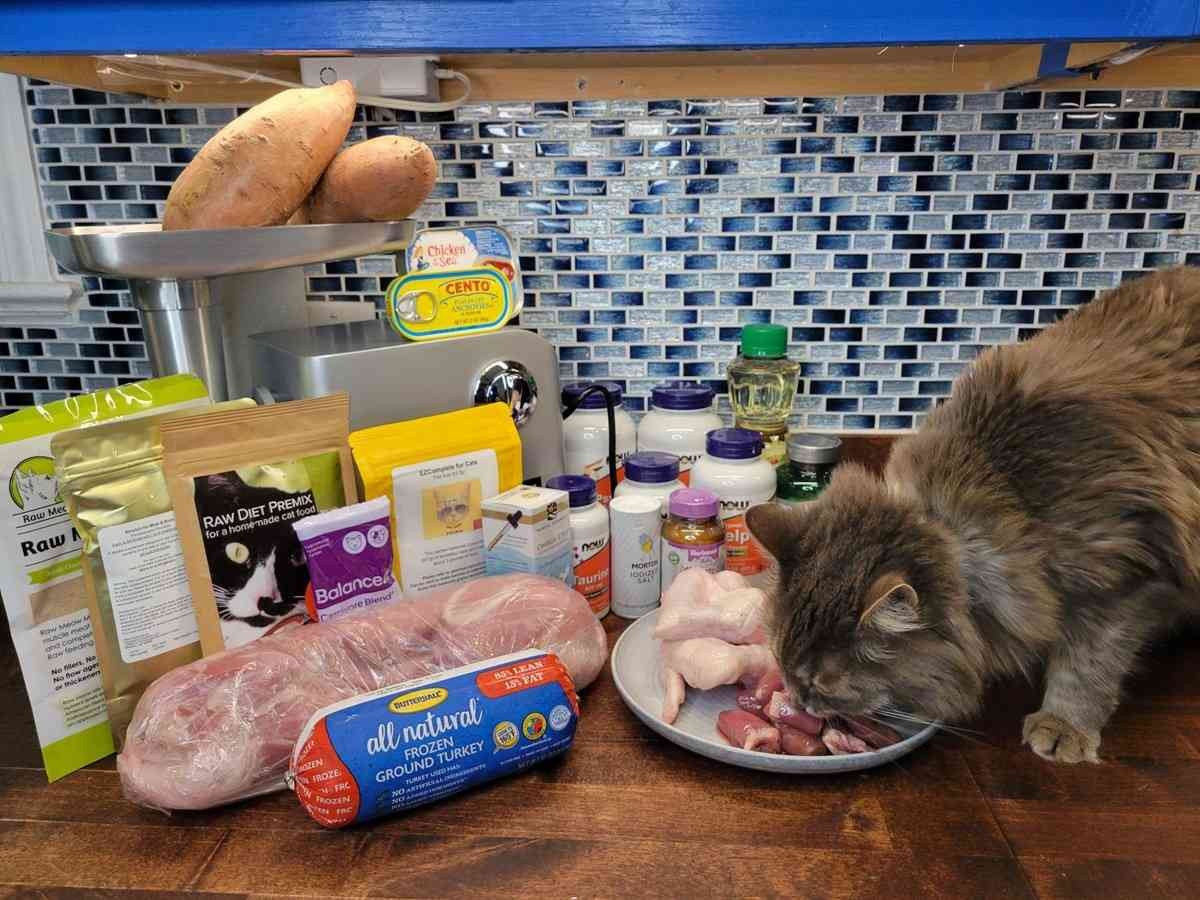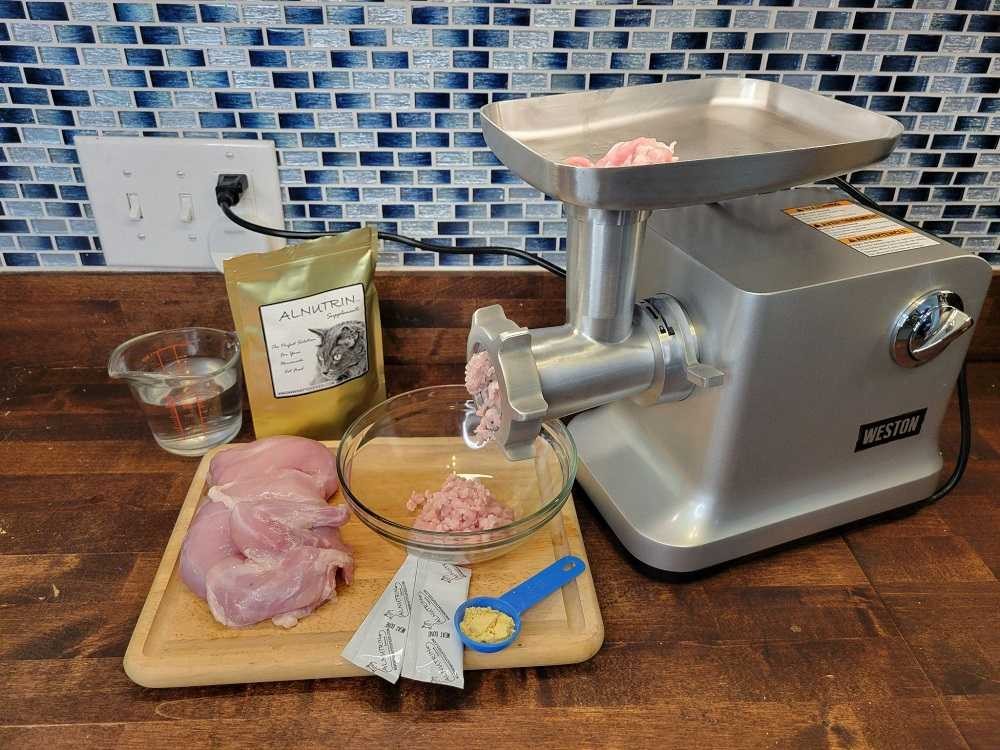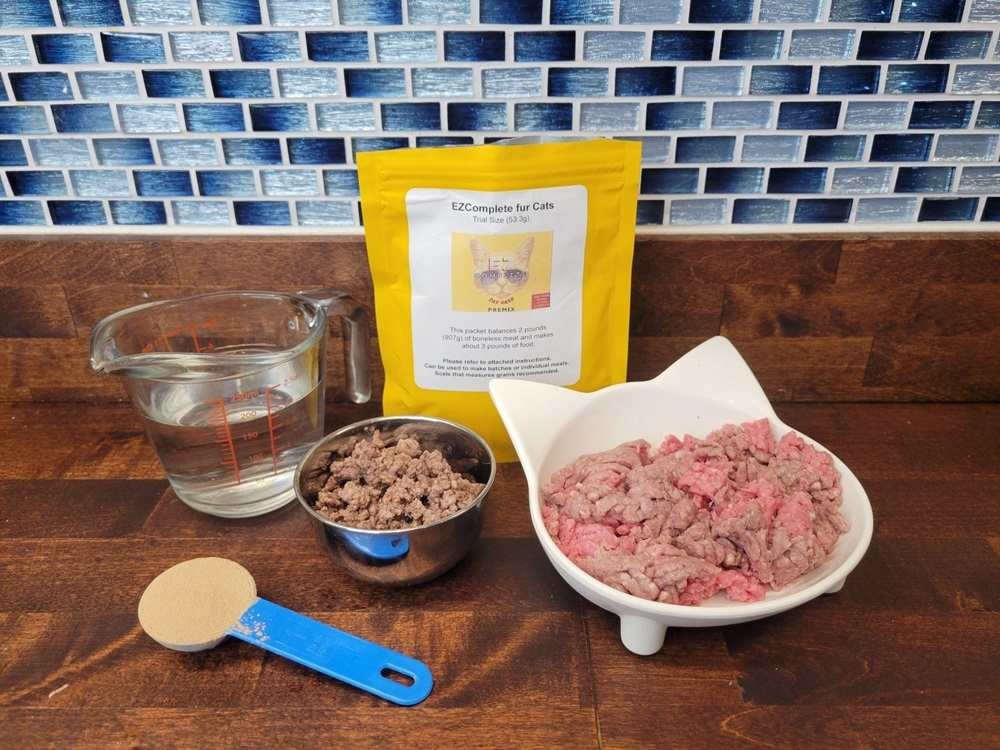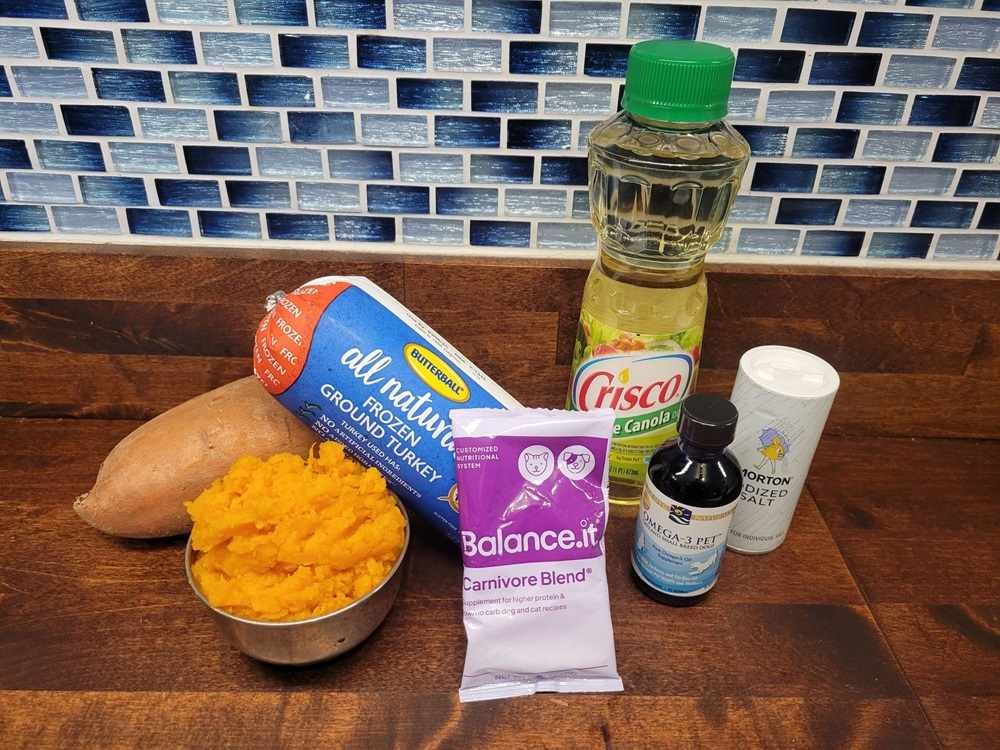Making Cat Food At Home is a loving way to cater to your feline friend’s unique nutritional needs, and FOODS.EDU.VN is here to guide you. Explore delicious and healthy homemade cat food recipes, focusing on providing optimal nutrition for your beloved companion. This in-depth guide offers solutions for creating balanced meals, using quality ingredients, and understanding feline dietary requirements. Uncover the best homemade diet plans and raw cat food options, while ensuring your cat’s well-being with the right information.
1. The Essentials of Making Cat Food at Home
1.1. Why Consider Homemade Cat Food?
Many cat owners are turning to homemade cat food for several compelling reasons. Commercial cat food can sometimes be filled with questionable ingredients, additives, and fillers. Making your cat food allows you to control exactly what goes into their diet, ensuring they receive high-quality, wholesome nutrition.
Homemade cat food can be a great option for cats with allergies or sensitivities to certain ingredients found in commercial foods. You can eliminate potential allergens and tailor the diet to meet your cat’s specific needs. Plus, many owners enjoy the satisfaction of providing their cats with fresh, nutritious meals made with love.
However, it’s crucial to understand that creating a balanced homemade diet requires knowledge and commitment. Cats have specific nutritional needs, and deficiencies can lead to serious health problems. Working with a veterinary nutritionist and using reliable recipes are essential to ensure your cat’s well-being.
Benefits of Homemade Cat Food:
- Control over ingredients
- Avoidance of additives and fillers
- Customization for allergies and sensitivities
- Fresh, wholesome nutrition
1.2. Understanding Feline Nutritional Needs
Cats are obligate carnivores, meaning their bodies are designed to thrive on a meat-based diet. They require specific nutrients, such as taurine, arginine, and arachidonic acid, which are primarily found in animal tissues.
A balanced feline diet should consist of:
- Protein: Essential for muscle development and overall health.
- Fat: Provides energy and supports healthy skin and coat.
- Vitamins and Minerals: Crucial for various bodily functions and immune system support.
- Taurine: An essential amino acid for heart and eye health.
Carbohydrates should be limited, as cats don’t efficiently digest them. Avoid ingredients like corn, wheat, and soy, which are often used as fillers in commercial cat food.
Key Feline Nutrients:
| Nutrient | Importance | Sources |
|---|---|---|
| Protein | Muscle development, overall health | Meat, poultry, fish |
| Fat | Energy, skin and coat health | Animal fats, fish oils |
| Taurine | Heart and eye health | Meat, poultry, fish |
| Vitamins | Various bodily functions, immune support | Organ meats, supplements |
| Minerals | Bone health, enzyme function | Bone meal, supplements |




1.3. Potential Risks and How to Avoid Them
While homemade cat food can be beneficial, it’s essential to be aware of the potential risks:
- Nutritional Imbalance: This is the most significant risk. Deficiencies in essential nutrients can lead to severe health problems, such as blindness, heart disease, and skeletal abnormalities.
- Contamination: Raw meat can carry harmful bacteria like Salmonella and E. coli. Proper handling and hygiene are crucial to prevent contamination.
- Bone Hazards: Feeding raw bones can be risky, as they can splinter and cause choking or internal damage.
To minimize these risks:
- Consult with a veterinary nutritionist to create a balanced recipe tailored to your cat’s needs.
- Use high-quality ingredients from reliable sources.
- Follow strict hygiene practices when handling raw meat.
- Consider using a premix supplement to ensure complete nutrition, or choose recipes developed by experts.
2. Key Ingredients for Homemade Cat Food
2.1. Protein Sources: Meat, Poultry, and Fish
Protein is the cornerstone of a healthy feline diet. Here are some excellent protein sources to include in your homemade cat food recipes:
- Chicken: A lean and easily digestible option, chicken provides essential amino acids and is often well-tolerated by cats.
- Turkey: Similar to chicken, turkey is a good source of protein and can be a great alternative for cats with chicken sensitivities.
- Beef: A rich source of protein and essential nutrients, beef should be lean to avoid excessive fat intake.
- Fish: Oily fish like salmon and mackerel are packed with omega-3 fatty acids, which are beneficial for skin and coat health.
- Rabbit: A novel protein source that is often recommended for cats with allergies or sensitivities.
Best Protein Sources for Cats:
| Protein Source | Benefits | Considerations |
|---|---|---|
| Chicken | Lean, easily digestible, good source of amino acids | Ensure it’s cooked thoroughly |
| Turkey | Lean, good alternative to chicken, rich in nutrients | Ensure it’s cooked thoroughly |
| Beef | Rich in protein and essential nutrients | Choose lean cuts to avoid excessive fat intake |
| Fish | High in omega-3 fatty acids, good for skin and coat | Limit intake due to potential mercury contamination |
| Rabbit | Novel protein, good for cats with allergies | Ensure it’s sourced from a reputable supplier |
2.2. Organ Meats: The Nutritional Powerhouse
Organ meats are incredibly nutrient-dense and should be included in your homemade cat food recipes. They are packed with essential vitamins, minerals, and amino acids that are vital for feline health.
- Liver: A rich source of vitamin A, iron, and copper, liver is essential for maintaining healthy vision, blood, and enzyme function.
- Heart: High in taurine, an essential amino acid for heart health, heart is a valuable addition to any feline diet.
- Kidney: Provides essential minerals and supports kidney function.
- Gizzard: A good source of protein and minerals, gizzard is a beneficial addition to homemade cat food.
Organ meats should make up about 10-15% of the total diet.
Nutritional Benefits of Organ Meats:
| Organ Meat | Key Nutrients | Benefits |
|---|---|---|
| Liver | Vitamin A, iron, copper | Healthy vision, blood, enzyme function |
| Heart | Taurine | Heart health |
| Kidney | Minerals | Kidney function |
| Gizzard | Protein, minerals | Overall health |
2.3. Supplements: Filling the Gaps
Even with a well-planned diet, supplements are often necessary to ensure your cat receives all the essential nutrients they need. Here are some key supplements to consider:
- Taurine: Cats cannot produce enough taurine on their own, so supplementation is crucial.
- Vitamin E: An antioxidant that supports immune function and protects against cell damage.
- B-Complex Vitamins: Essential for energy metabolism and nerve function.
- Omega-3 Fatty Acids: Beneficial for skin and coat health, as well as joint function.
- Bone Meal or Calcium Supplement: Essential for bone health, especially when not using bone in the recipe.
When choosing supplements, opt for high-quality products from reputable brands. Consult with your veterinarian or a veterinary nutritionist to determine the appropriate dosages for your cat.
Essential Supplements for Homemade Cat Food:
| Supplement | Benefits | Considerations |
|---|---|---|
| Taurine | Essential for heart and eye health | Always include in homemade cat food |
| Vitamin E | Antioxidant, supports immune function | Use a natural form of vitamin E |
| B-Complex Vitamins | Energy metabolism, nerve function | Important for overall health |
| Omega-3 Fatty Acids | Skin and coat health, joint function | Choose fish oil or algae-based supplements |
| Bone Meal/Calcium | Bone health | Necessary when not using bone in the recipe |
3. Homemade Cat Food Recipes
Disclaimer: These recipes are intended as examples and should be reviewed by a veterinary nutritionist to ensure they meet your cat’s specific needs.
3.1. Balanced Chicken and Liver Recipe
This recipe uses chicken and liver as the primary protein sources and includes essential supplements for a balanced diet.
Ingredients:
- 3 lbs boneless, skinless chicken thighs
- 7 oz chicken liver
- 8 oz water
- 4 raw egg yolks
- 2000 mg taurine
- 4000 mg wild salmon oil capsules
- 200 mg Vitamin B Complex
- 200 IU Vitamin E
- 1 ½ tsp lite iodized salt
- 4 tsp psyllium husk powder
Instructions:
- Cut the chicken thighs and liver into 1-inch pieces.
- Grind the chicken and liver together.
- In a small bowl, whisk the egg yolks together with the water and supplements.
- Pour the mixture over the ground chicken and liver and mix well.
- Portion the mixture into smaller containers and freeze.
Nutrient Content (Approximate):
- Protein: 53.53%
- Fat: 33.06%
- Fiber: 0.81%
- Ash: 2.75%
- Carbs: 1.96%
3.2. Turkey and Sweet Potato Recipe (using Balance IT® Carnivore Blend® Premix)
This recipe uses a premix supplement to ensure a complete and balanced diet.
Ingredients:
- 3 ⅜ oz (96g) cooked turkey breast
- 1 ⅝ tsp (7g) canola oil
- ⅖ ml (0.37g) Nordic Naturals Omega-3 Pet Liquid
- 5/16 cup (63g) baked sweet potato
- ⅛ tsp (0.75g) Morton Iodized Salt
- ¾ tsp (3.07g) Balance IT Carnivore Blend
Instructions:
- Roast the turkey breast at 350℉ until it reaches an internal temperature of 165℉.
- Bake the sweet potato until the flesh is tender.
- Scoop the flesh from the sweet potato out of the skin and weigh out the desired portion.
- Finely chop the turkey breast then weigh out the amount needed.
- Combine the sweet potato and turkey in a mixing bowl.
- Add the supplements and stir well to combine.
- Divide into the desired number of meals, feeding one immediately.
- Store the leftovers in an airtight container in the refrigerator.
Nutrient Content (Approximate):
- Protein: 47.73%
- Fat: 32.59%
- Carbs: 19.68%
3.3. Raw Ground Rabbit Recipe (using Alnutrin for Meat & Bone)
This recipe uses ground rabbit meat, bones, and organs, supplemented with Alnutrin premix to ensure a balanced raw diet.
Ingredients:
- 1 pack (4g) Alnutrin for Meat & Bone
- ¼ cup (60g) water
- 1 lb (454g) ground raw rabbit meat & bones
Instructions:
- In a small bowl, whisk together the Alnutrin and water.
- Stir the mixture into the ground rabbit.
- Divide into portions and freeze.
Nutrient Content (Approximate):
- Protein: 65.3%
- Fat: 15.7%
- Fiber: NA
- Ash: 3.44%
- Carbs: 0%
4. Guidelines for Making and Storing Homemade Cat Food
4.1. Food Safety and Hygiene
When working with raw meat, it’s essential to follow strict hygiene practices to prevent contamination:
- Wash your hands thoroughly before and after handling raw meat.
- Use separate cutting boards and utensils for raw meat and other ingredients.
- Clean and disinfect all surfaces and equipment that come into contact with raw meat.
- Store raw meat in the refrigerator at or below 40°F (4°C).
- Thaw raw meat in the refrigerator, not at room temperature.
- Do not leave raw meat at room temperature for more than two hours.
4.2. Portioning and Feeding Schedules
The amount of food your cat needs depends on their age, weight, activity level, and overall health. As a general guideline, adult cats need about 200 calories per day, or about 6 ounces of homemade food.
Divide the daily ration into two or three meals. Feed your cat at consistent times each day to establish a regular eating schedule.
Feeding Guidelines:
| Cat Weight | Daily Calorie Needs | Approximate Food Amount |
|---|---|---|
| 5 lbs | 160 calories | 4 ounces |
| 10 lbs | 240 calories | 6 ounces |
| 15 lbs | 300 calories | 7.5 ounces |
4.3. Storage and Freezing
Homemade cat food should be stored in the refrigerator in airtight containers. It will keep for 2-3 days.
For longer storage, freeze the food in individual portions. Frozen cat food will keep for up to three months. Thaw the food in the refrigerator before serving.
5. Specialized Diets for Cats with Health Conditions
5.1. Homemade Diets for Cats with Allergies
If your cat has food allergies, a homemade diet can be a great way to control their symptoms. Work with your veterinarian to identify the specific allergens and eliminate them from the diet.
Novel protein sources like rabbit, venison, or duck are often recommended for cats with allergies. Avoid common allergens like chicken, beef, fish, and dairy.
5.2. Homemade Diets for Cats with Kidney Disease
Cats with kidney disease require a diet that is low in phosphorus and moderate in protein. Homemade diets can be tailored to meet these needs.
Consult with your veterinarian or a veterinary nutritionist to create a recipe that is appropriate for your cat’s specific condition.
5.3. Homemade Diets for Cats with Diabetes
Diabetic cats need a diet that is low in carbohydrates and high in protein. Homemade diets can be formulated to meet these requirements.
Avoid ingredients like grains, potatoes, and fruits, which are high in carbohydrates. Focus on lean protein sources like chicken, turkey, and fish.
6. Choosing the Right Tools and Equipment
6.1. Essential Kitchen Tools
To make homemade cat food, you’ll need the following essential kitchen tools:
- Food Processor or Meat Grinder: For grinding meat and organs.
- Cutting Boards: Use separate cutting boards for raw meat and other ingredients.
- Knives: Sharp knives for chopping and slicing ingredients.
- Mixing Bowls: For combining ingredients.
- Measuring Cups and Spoons: For accurate measurements.
- Airtight Containers: For storing food in the refrigerator or freezer.
6.2. Recommended Appliances
Consider investing in these appliances to make the process easier:
- Slow Cooker: For cooking meat.
- Food Scale: For accurate measurements.
- Freezer: For storing food in bulk.
6.3. Where to Buy Quality Ingredients
Source your ingredients from reputable suppliers to ensure quality and safety:
- Local Butchers: Can provide high-quality meat and organs.
- Farmers Markets: Offer fresh, seasonal produce.
- Online Retailers: Offer a wide variety of ingredients and supplements.
7. Addressing Common Concerns
7.1. “Is Homemade Cat Food More Expensive?”
The cost of homemade cat food depends on the ingredients you choose. High-quality ingredients can be more expensive than commercial cat food. However, you can save money by buying in bulk and using less expensive protein sources like chicken and turkey.
7.2. “How Do I Transition My Cat to a Homemade Diet?”
Transition your cat to a homemade diet gradually to avoid digestive upset. Start by mixing a small amount of the homemade food with their current food. Gradually increase the amount of homemade food over 7-10 days until they are eating only the homemade diet.
7.3. “What If My Cat Doesn’t Like the Homemade Food?”
Some cats are picky eaters. If your cat doesn’t like the homemade food, try these tips:
- Warm the food slightly to enhance the aroma.
- Add a small amount of tuna or salmon to the food.
- Try a different recipe.
8. Resources and Further Reading
8.1. Websites and Books
Here are some valuable resources for learning more about homemade cat food:
- Feline Nutrition Foundation: Offers information and resources on raw feeding for cats.
- The Little Carnivore: Provides recipes and guidance on prey model raw diets.
- Balance IT: Offers premix supplements and recipe formulation services.
8.2. Consulting with a Veterinary Nutritionist
Working with a veterinary nutritionist is essential to ensure your homemade diet is balanced and meets your cat’s specific needs. A veterinary nutritionist can help you:
- Formulate a recipe tailored to your cat’s age, weight, activity level, and health condition.
- Determine the appropriate supplement dosages.
- Monitor your cat’s health and adjust the diet as needed.
9. Conclusion: A Loving Choice for Your Cat’s Health
Making cat food at home can be a rewarding experience, allowing you to provide your feline friend with fresh, nutritious meals tailored to their specific needs. By understanding feline nutritional requirements, using high-quality ingredients, and consulting with a veterinary nutritionist, you can create a homemade diet that supports your cat’s health and well-being.
Remember, it’s important to approach homemade cat food with knowledge, care, and commitment. With the right information and guidance, you can make a loving choice that benefits your cat’s health and happiness.
Ready to Explore More?
At FOODS.EDU.VN, we’re passionate about providing you with the knowledge and resources you need to make informed decisions about your cat’s diet. Discover more in-depth articles, detailed recipes, and expert tips on our website.
Address: 1946 Campus Dr, Hyde Park, NY 12538, United States
Whatsapp: +1 845-452-9600
Website: foods.edu.vn
10. Frequently Asked Questions About Homemade Cat Food
10.1. Is homemade cat food safe?
Yes, homemade cat food is safe when properly prepared and balanced. Follow strict hygiene practices, use high-quality ingredients, and consult with a veterinary nutritionist to ensure your cat’s dietary needs are met.
10.2. How much does homemade cat food cost?
The cost varies depending on the ingredients. It can be more expensive than commercial food if you use premium ingredients, but buying in bulk and using less expensive protein sources can help reduce costs.
10.3. Is raw cat food better than cooked?
Raw cat food is considered biologically appropriate, but it’s not suitable for every cat or owner. Raw meat can contain bacteria. Research and compare options to decide what’s best for your cat.
10.4. How much should I feed my cat?
The average adult cat needs about 200 calories per day, or about 6 ounces of homemade food. Adjust based on your cat’s weight, activity level, and health condition.
10.5. Can I use human food for my cat?
Some human foods are safe for cats, but many are not. Always research before feeding human food to your cat and avoid toxic ingredients like chocolate, onions, and garlic.
10.6. What are the signs of a nutritional deficiency in cats?
Signs include weight loss, poor coat quality, lethargy, muscle weakness, and specific health problems related to the deficiency. Consult your vet if you notice any of these signs.
10.7. How often should I change my cat’s diet?
Changes should be gradual to avoid digestive upset. If you’re switching to a new recipe or ingredient, introduce it slowly over 7-10 days.
10.8. Can homemade cat food help with urinary problems?
A homemade diet can help with urinary problems by controlling mineral content and promoting hydration. Consult with your vet for a tailored diet plan.
10.9. What are the best supplements for homemade cat food?
Essential supplements include taurine, vitamin E, B-complex vitamins, omega-3 fatty acids, and bone meal or calcium.
10.10. How do I know if my cat is getting enough taurine?
Ensure your recipe includes taurine-rich ingredients like heart or liver, or supplement with taurine powder. Look for signs of taurine deficiency, such as vision problems or heart issues, and consult your vet if you’re concerned.
